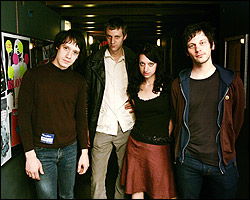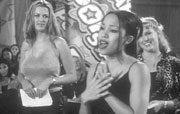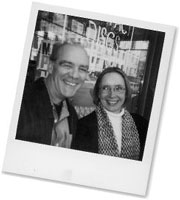Let’s be honest: For a long, long, long time now, there has been nothing new to say about votives and scented tapers, or the candleholders you put them in. Every mall in America has at least one store that stocks a ridiculous assortment of perfumed pillars and jam-scented candles, and particularly at this time of year, seasonally themed, manger-shaped, and otherwise hokey candleholders flood the market. So what makes the locally crafted line of glass goblets called Glassybabies so special?
First of all, it’s color. Glassybabies come in deep, saturated cerulean blue, delicate pale pink, and more shades of green than most gardens can produce. Then there’s the weight; they feel significant. Hand-blown by a team of four or five local artisan glassblowers—the last of whom brands the Glassybaby name into the bottom so you know it’s one of a handmade collection—these functional objects are made chic and vibrant by a sturdy, modernized arts-and-crafts aesthetic that matches the fairly hefty price tag ($35 each). But what really makes Glassybabies unique is the Glassybaby story.
IN 1998, WHILE fighting her third round of cancer, Lee Rhodes arranged to give her then husband the gift of glassblowing lessons. After the obligatory ornamental glass ball that is the typical first project of all new glassblowers came the obligatory small glass cups, and Rhodes was immediately taken with the short, intensely colored goblets that he brought home. Rhodes filled her house with the glasses, which she filled with small candles. Inspired by the healing, spirit-lifting qualities of the light, Rhodes signed up for glassblowing lessons at Ballard’s Art by Fire as soon as she recovered and began to make the glasses herself. Soon after that, she was selling them to friends and friends of friends out of her garage.
Three years and many, many Glassybabies since, Rhodes’ simple business model is now an eponymous concept. Her Green Lake store and studio and each deeply colored, cutely christened glass holder (the palette includes “Seattle sunset,” “wet dog,” and “sour apple”) all use the “Glassybaby” name. On the tag that comes affixed to each ready-to-go (or ready-to-ship) ‘baby, Rhodes and her partners refer to their product as a “votive, vessel, [or] vase.” There’s an unspoken notion that they’ve created a noun—a word for an object that’s in between a pet rock, a spiritual movement, and a piece of usable, glowing art. Glossy posters on the walls of Glassybaby’s loft-style space showcase the company’s simple, sole (for now, at least) product in the latest shade of natural, lead-free orange and ask, “What color is your Glassybaby?” From the light-and-candle filled storefront, shoppers can watch through large windows as the young, mostly dreadlocked production line in the “hot shop” studio below carefully craft their products. The casual atmosphere, teamwork vibe, and dance music make the entire space feel as much like a place to hang out as a place to shop.
And that’s part of the Glassybaby plan, too. Orders come in steadily from Rhodes’ Web site, and there’s a remarkable amount of foot traffic that’s still largely due to word of mouth (so far, Glassybaby hasn’t advertised or done any art or gift shows), but Rhodes wants the space to be used for gatherings and fund-raisers, as well. She and her partners offer the studio as a place to host book-club parties or other group events, and they’ll donate 10 percent of all sales generated during the evening to the charity, organization, or individual of your choice. Giving is another important part of Rhodes’ plan; 10 percent of the revenue generated by all “true white” Glassybabies is given to the Seattle Cancer Care Alliance.
Rhodes and the friends and family she’s brought in to work with her—some of whom have also experienced cancer—speak rather passionately and emphatically about the lights and colors around them, but when you see a table full of Glassybabies grouped together in the shop or in restaurants like Nishino and Monsoon, you can’t argue with Rhodes’ memories of their soothing properties and you can’t help but picture them spread throughout your own rooms. After all, there’s a reason that candles and their holders have become such ubiquitous gifts.
CLASS GLASS
Thanks in part to Dale Chihuly, the Northwest is a great place to get behind some goggles on the inside of a “hot shop.” Lots of local studios and schools offer beginner classes, and because glassblowing is sort of a team sport and teacher-student ratios are always in your favor, you get to actually blow, shape, and create pieces right away. Use this list to find out more about giving the gift of hands-on glassblowing classes.
Art by Fire
5465 Leary Ave N.W, 206-789-1490
Courses in beginning and advanced glassblowing run in concurrent four-week sessions throughout the year; each class meets for four hours per week ($430).
Seattle Glassblowing Studio
2227 Fifth Ave., 206-448-2181
Beginner classes run for six weeks; each class is four hours long ($645). The weekend intensive is recommended for gift-giving; the course consists of two four-hour sessions ($225).
Pratt Glass Studios
1902 South Main St., 206-328-2200
All levels, and many techniques, of glassblowing are taught at the fine-arts center in the Central District. An eight-class series is $620 for nonmembers. Weekend introduction intensives are offered for $325 for nonmembers; classes for high-school students are also available.
Laura Cassidy
Glassybaby Studio and Store, 427 N.E. 72nd Place, 206-568-7368; www.glassybaby.com. Open 10 a.m.–3 p.m. Mon.–Sat.








